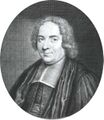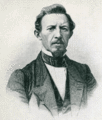Template:Selected anniversaries/December 23: Difference between revisions
Jump to navigation
Jump to search
No edit summary |
No edit summary |
||
| (12 intermediate revisions by the same user not shown) | |||
| Line 1: | Line 1: | ||
<gallery> | <gallery> | ||
|| *** | || *** DONE: Pics *** | ||
File:Pierre Varignon.jpg|link=Pierre Varignon (nonfiction|1722: Mathematician and academic [[Pierre Varignon (nonfiction)|Pierre Varignon]] dies. He simplified the proofs of many propositions in mechanics, adapted Leibniz's calculus to the inertial mechanics of Newton's ''Principia'', and treated mechanics in terms of the composition of forces. | || *** THEME: Submarines *** | ||
File:Pierre Varignon.jpg|link=Pierre Varignon (nonfiction)|1722: Mathematician and academic [[Pierre Varignon (nonfiction)|Pierre Varignon]] dies. He simplified the proofs of many propositions in mechanics, adapted Leibniz's calculus to the inertial mechanics of Newton's ''Principia'', and treated mechanics in terms of the composition of forces. | |||
||1722: Baron Axel Fredrik Cronstedt born ... mineralogist and chemist who discovered nickel in 1751as a mining expert with the Bureau of Mines. Cronstedt is one of the founders of modern mineralogy. Pic. | ||1722: Baron Axel Fredrik Cronstedt born ... mineralogist and chemist who discovered nickel in 1751as a mining expert with the Bureau of Mines. Cronstedt is one of the founders of modern mineralogy. Pic. | ||
| Line 9: | Line 11: | ||
||1766: Wilhelm Hisinger born ... physicist and chemist. Pic. | ||1766: Wilhelm Hisinger born ... physicist and chemist. Pic. | ||
||1790: Jean-François Champollion born ... scholar, philologist and orientalist, known primarily as the decipherer of Egyptian hieroglyphs and a founding figure in the field of Egyptology. The significance of Champollion's decipherment was that he showed many previous assumptions about ancient Egypt to be wrong, making it possible to begin to retrieve many kinds of information recorded by the ancient Egyptians. Pic. | |||
File:Wilhelm Bauer.gif|link=Wilhelm Bauer (nonfiction)|1822: Inventor and engineer [[Wilhelm Bauer (nonfiction)|Wilhelm Bauer]] born. He will design and invent [[Submarine (nonfiction)|submarines]]. | File:Wilhelm Bauer.gif|link=Wilhelm Bauer (nonfiction)|1822: Inventor and engineer [[Wilhelm Bauer (nonfiction)|Wilhelm Bauer]] born. He will design and invent [[Submarine (nonfiction)|submarines]]. | ||
| Line 20: | Line 24: | ||
||1900: Otto Soglow born ... cartoonist. Pic. | ||1900: Otto Soglow born ... cartoonist. Pic. | ||
||1907: Pierre | ||1907: Pierre Janssen dies ... astronomer who, along with English scientist Joseph Norman Lockyer, is credited with discovering the gaseous nature of the solar chromosphere, and with some justification the element helium. Pic. | ||
||1908: Hugo Hadwiger dies ... mathematician, known for his work in geometry, combinatorics, and cryptography. Pic. | ||1908: Hugo Hadwiger dies ... mathematician, known for his work in geometry, combinatorics, and cryptography. Pic. | ||
| Line 30: | Line 34: | ||
||1923: Harold Masursky born ... geologist and senior scientist at the U.S. Geological Survey's astrogeology branch supporting space exploration. Starting in the mid 1960s, he helped analyze the photographs from the Ranger, Lunar Orbiter, and Surveyor lunar missions. In mapping the moon, suitable landing spots were being sought for the unmanned Surveyor 5 spacecraft (1967) and the manned Apollo landings (1969-72). Masursky headed the group that interpreted television transmissions from Martian satellite Mariner 9 (1971), producing maps to plan the landing of unmanned Viking spacecraft on Mars (1976). He analyzed data on the geological origins and evolution of the planets. He collaborated in foreign projects such as the Soviet Venus probes. Pic: https://www.todayinsci.com/8/8_24.htm | ||1923: Harold Masursky born ... geologist and senior scientist at the U.S. Geological Survey's astrogeology branch supporting space exploration. Starting in the mid 1960s, he helped analyze the photographs from the Ranger, Lunar Orbiter, and Surveyor lunar missions. In mapping the moon, suitable landing spots were being sought for the unmanned Surveyor 5 spacecraft (1967) and the manned Apollo landings (1969-72). Masursky headed the group that interpreted television transmissions from Martian satellite Mariner 9 (1971), producing maps to plan the landing of unmanned Viking spacecraft on Mars (1976). He analyzed data on the geological origins and evolution of the planets. He collaborated in foreign projects such as the Soviet Venus probes. Pic: https://www.todayinsci.com/8/8_24.htm | ||
||1931: Basil Gordon born ... mathematician at UCLA, specializing in number theory and combinatorics.[1] He obtained his Ph.D. at California Institute of Technology under the supervision of Tom Apostol. Ken Ono was one of his students. Gordon is well known for Göllnitz–Gordon identities, generalizing the Rogers–Ramanujan identities. | ||1931: Basil Gordon born ... mathematician at UCLA, specializing in number theory and combinatorics.[1] He obtained his Ph.D. at California Institute of Technology under the supervision of Tom Apostol. Ken Ono was one of his students. Gordon is well known for Göllnitz–Gordon identities, generalizing the Rogers–Ramanujan identities. He also posed the still-unsolved Gaussian moat problem in 1962. Pic: https://www.math.ucla.edu/news/memoriam-basil-gordon-professor-mathematics-emeritus-1931-%E2%80%93-2012 | ||
||1932: Theoretical physicist Thomas Kibble born ... research interests were in quantum field theory, especially the interface between high-energy particle physics and cosmology. He is best known as one of the first to describe the Higgs mechanism, and for his research on topological defects. From the 1950s he was concerned about the nuclear arms race and from 1970 took leading roles in promoting the social responsibility of the scientist. Pic. | |||
||1933: Rikitarō Fujisawa dies | File:Fujisawa Rikitaro.jpg|link=Rikitarō Fujisawa (nonfiction)|1933: Mathematician [[Rikitarō Fujisawa (nonfiction)|Rikitarō Fujisawa]] dies. During the Meiji era he was instrumental in reforming mathematics education in Japan and establishing the ideas of European mathematics in Japan. | ||
||1939: Anthony Fokker dies ... pilot and engineer, designed the Fokker Dr.I and Fokker D.VII. Pic (dashing). | ||1939: Anthony Fokker dies ... pilot and engineer, designed the Fokker Dr.I and Fokker D.VII. Pic (dashing). | ||
| Line 39: | Line 45: | ||
||1939: Ludwig Hopf dies ... theoretical physicist who made contributions to mathematics, special relativity, hydrodynamics, and aerodynamics. Pic: https://www.geni.com/people/Prof-Dr-Ludwig-Hopf/6000000003495136149 | ||1939: Ludwig Hopf dies ... theoretical physicist who made contributions to mathematics, special relativity, hydrodynamics, and aerodynamics. Pic: https://www.geni.com/people/Prof-Dr-Ludwig-Hopf/6000000003495136149 | ||
||1944: The Great Papago Escape was the largest Axis prisoner-of-war escape to occur from an American facility during World War II. On the night of December 23, 1944, twenty-five Germans tunneled out of Camp Papago Park, near Phoenix, Arizona, and fled into the surrounding desert. All of the escapees were eventually recaptured without bloodshed over the next few weeks, and although most were detained within Maricopa County, a few nearly made it to the border of Mexico, which is about 130 miles south of the camp. Pic. | |||
||1947: The transistor is first demonstrated at Bell Laboratories. | ||1947: The transistor is first demonstrated at Bell Laboratories. | ||
||1949: Arthur Eichengrün dies ... chemist, materials scientist, and inventor. He is known for developing the highly successful anti-gonorrhea drug Protargol, the standard treatment for 50 years until the adoption of antibiotics, and for his pioneering contributions in plastics. Pic. | ||1949: Arthur Eichengrün dies ... chemist, materials scientist, and inventor. He is known for developing the highly successful anti-gonorrhea drug Protargol, the standard treatment for 50 years until the adoption of antibiotics, and for his pioneering contributions in plastics. Pic. | ||
||1953: Lavrentiy Pavlovich Beria born ... Soviet politician of Georgian ethnicity, Marshal of the Soviet Union and state security administrator, chief of the Soviet security and secret police apparatus (NKVD) under Joseph Stalin during World War II. | ||1953: Lavrentiy Pavlovich Beria born ... Soviet politician of Georgian ethnicity, Marshal of the Soviet Union and state security administrator, chief of the Soviet security and secret police apparatus (NKVD) under Joseph Stalin during World War II. Pic. | ||
||1954: First successful kidney transplant is performed by J. Hartwell Harrison and Joseph Murray. | ||1954: First successful kidney transplant is performed by J. Hartwell Harrison and Joseph Murray. | ||
||1968: The 82 sailors from the USS Pueblo are released after eleven months of internment in North Korea. | ||1968: The 82 sailors from the USS ''Pueblo'' are released after eleven months of internment in North Korea. | ||
||1971: Hugh Rose Foss born ... cryptanalyst. At Bletchley Park during World War II he made significant contributions both to the breaking of the German Enigma code and headed the section tasked with breaking Japanese Naval codes. | ||1971: Hugh Rose Foss born ... cryptanalyst. At Bletchley Park during World War II he made significant contributions both to the breaking of the German Enigma code and headed the section tasked with breaking Japanese Naval codes. Pic search. | ||
||1972: Andrei Tupolev dies ... engineer, designed the Tupolev Tu-95 and Tupolev Tu-104. Pic. | ||1972: Andrei Tupolev dies ... engineer, designed the Tupolev Tu-95 and Tupolev Tu-104. Pic. | ||
| Line 65: | Line 71: | ||
||1989: Richard Rado dies ... mathematician whose research concerned combinatorics and graph theory. In graph theory, the Rado graph, a countably infinite graph containing all countably infinite graphs as induced subgraphs, is named after Rado. He rediscovered it in 1964 after previous works on the same graph by Wilhelm Ackermann, Paul Erdős, and Alfréd Rényi. Pic. | ||1989: Richard Rado dies ... mathematician whose research concerned combinatorics and graph theory. In graph theory, the Rado graph, a countably infinite graph containing all countably infinite graphs as induced subgraphs, is named after Rado. He rediscovered it in 1964 after previous works on the same graph by Wilhelm Ackermann, Paul Erdős, and Alfréd Rényi. Pic. | ||
||1992: Robert Marshak dies ... American physicist dedicated to learning, research, and education. Pic. | |||
||2001: Donald Clayton Spencer dies ... mathematician, known for work on deformation theory of structures arising in differential geometry, and on several complex variables from the point of view of partial differential equations. Pic: https://www.geni.com/people/Donald-Spencer/6000000000566571886 | ||2001: Donald Clayton Spencer dies ... mathematician, known for work on deformation theory of structures arising in differential geometry, and on several complex variables from the point of view of partial differential equations. Pic: https://www.geni.com/people/Donald-Spencer/6000000000566571886 | ||
| Line 73: | Line 81: | ||
||December 23 is the fictional date of the [[Zendian problem (nonfiction)|Zendian problem]], a US Army cryptography training exercise involving 375 radio messages said to have been intercepted on December 23 by the US Army contingent of a United Nations force landed on the fictional island of Zendia in the Pacific Ocean. | ||December 23 is the fictional date of the [[Zendian problem (nonfiction)|Zendian problem]], a US Army cryptography training exercise involving 375 radio messages said to have been intercepted on December 23 by the US Army contingent of a United Nations force landed on the fictional island of Zendia in the Pacific Ocean. | ||
</gallery> | </gallery> | ||
Latest revision as of 17:30, 7 February 2022
1722: Mathematician and academic Pierre Varignon dies. He simplified the proofs of many propositions in mechanics, adapted Leibniz's calculus to the inertial mechanics of Newton's Principia, and treated mechanics in terms of the composition of forces.
1822: Inventor and engineer Wilhelm Bauer born. He will design and invent submarines.
1933: Mathematician Rikitarō Fujisawa dies. During the Meiji era he was instrumental in reforming mathematics education in Japan and establishing the ideas of European mathematics in Japan.


